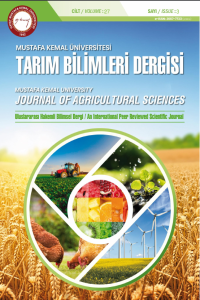Su kısıtı uygulamalarının şaraplık üzüm çeşitlerinde (Vitis vinifera L.) kök morfolojik özellikleri üzerine etkileri
Öz
Amaç: Bu çalışmada, Trakya bölgesinde yetiştirilen şaraplık üzüm çeşitlerinin köklerinin morfolojik özellikleri üzerine su kısıtı uygulamalarının etkilerinin belirlenmesi amaçlanmıştır.
Yöntem ve Bulgular: Deneme, bilgisayar kontrollü sulama ve bitki besleme sistemi kullanılarak 14 L saksılarda ve perlit yetiştirme ortamında gerçekleştirilmiştir. ‘Adakarası’, ‘Papazkarası’, ‘Vasilaki’, ‘Yapıncak’ ve ‘Cabernet Sauvignon’ çeşitlerine günlük 4 farklı toplam su miktarı ve sulama yapılmaması dahil olmak üzere farklı su kısıtlamaları uygulanmıştır. 2 yetiştirme sezonu sonunda bitkiler sökülerek, emici ve kalın köklerin sayısı, uzunluğu, çapı, ağırlığı ve gövde çapı parametreleri belirlenmiştir.
Genel Yorum: Çalışılan parametrelerin hiçbiri çeşitlerin kuraklık toleransını tam olarak tanımlamada tek başına yeterli olmasa da çeşitlerin su stresine karşı genotipik tepkisini tanımlamada önemli oldukları belirlemiştir. ‘Adakarası’ çeşidi, azalan su içeriğine ‘Cabernet Sauvignon’'a benzer şekilde tepki vermiştir. ‘Papazkarası’ çeşidinde kök sayısının fazla olması susuz koşullara uyum açısından bir avantaj olarak değerlendirilebilir. Diğer yandan, ‘Yapıncak’ ve ‘Vasilaki’ çeşitleri düşük suya vejetatif büyümeyi azaltarak tepki vermektedir.
Anahtar Kelimeler
Vitis İklim değişikliği Yerel üzüm çeşitleri Adaptasyon Abiyotik stres
Proje Numarası
TAGEM/BBAD/B/19/A1/P6/06
Kaynakça
- Alsina MM, Smart DR, Bauerle T, De Herralde F, Biel C, Stockert C, Negron C, Save R (2011) Seasonal changes of whole root system conductance by a drought-tolerant grape root system. J Exp. Bot. 62: 99–109. https://doi.org/10.1093/jxb/erq247
- Baeza P, Junquera P, Peiro E, Lissarrague JR, Uriarte D, Vilanova M (2019) Effects of vine water status on yield components, vegetative response and must and wine composition. In: Advances in Grape and Wine Biotechnology (Eds. Morata A, Loira I). IntechOpen. https://doi.org/10.5772/intechopen.87042
- Balda P, Ibáñez J, Sancha JC, Toda FM (2014) Characterization and identification of minority red grape varieties recovered in Rioja, Spain. Am. J. Enol. Vitic. 65: 148-152. https://doi.org/ 10.5344/ajev.2013.13050
- Bassirirad H (2000) Kinetics of nutrient uptake by roots: Responses to global change. New Phytol. 147: 155–169. https://doi.org/10.1046/j.1469-8137.2000.00682.x
- Bauerle TL, Smart DR, Bauerle WL, Stockert C, Eissenstat DM (2008) Root foraging in response to heterogeneous soil moisture in two grapevines that differ in potential growth rate. New Phytol 179: 857–866. https://doi.org/10.1111/j.1469-8137.2008.02489.x
Effects of restricted irrigation on root morphological properties of wine grapes (Vitis vinifera L.)
Öz
Aims: This study sought to determine the effects of the application of water restrictions on the morphological characteristics of the roots of wine grape varieties grown in the Thrace region.
Methods and Results: The experiment was conducted in 14 L pots and perlite growth medium using a computerised irrigation and nutrition system. Different water restrictions were applied to ‘Adakarası’, ‘Papazkarası’, ‘Vasilaki’, ‘Yapıncak’ and ‘Cabernet Sauvignon’ cultivars, including 4 different daily total water amounts and no irrigation. At the end of 2 growing seasons, plants were removed and the parameters of number, length, diameter, weight of fine and coarse roots and trunk diameter were determined.
Conclusions: Although none of the studied parameters is sufficient to define exactly the drought tolerance of the cultivars, it shows that they are important for defining the genotypic response of the cultivars to water stress. The cultivar ‘Adakarası’ responds to decreasing water content similarly to ‘Cabernet Sauvignon’. The high number of roots in the ‘Papazkarası’ cultivar can be considered an advantage in terms of adaptation to drought conditions. On the other hand, the ‘Yapıncak’ and ‘Vasilaki’’ cultivars respond to low water with reduced vegetative growth.
Significance and Impact of the Study: In this study, root morphological characteristics of traditionally grown wine cultivars in the Thrace region were investigated for the first time. Knowledge of these traits is important for the adaptability and to take advantage of genetic diversity of local cultivars for the sustainability of viticulture under current climate change conditions.
Anahtar Kelimeler
Vitis Climate change Local grape cultivars Adaptation Abiotic stress.
Destekleyen Kurum
TAGEM
Proje Numarası
TAGEM/BBAD/B/19/A1/P6/06
Teşekkür
Authors SC and EB were planned and designed the trial. SC, EKD, ME and TA performed the field experiments and measurements. İK and EB made critical revisions of the manuscript for intellectual content. All authors read and approved the final manuscript.
Kaynakça
- Alsina MM, Smart DR, Bauerle T, De Herralde F, Biel C, Stockert C, Negron C, Save R (2011) Seasonal changes of whole root system conductance by a drought-tolerant grape root system. J Exp. Bot. 62: 99–109. https://doi.org/10.1093/jxb/erq247
- Baeza P, Junquera P, Peiro E, Lissarrague JR, Uriarte D, Vilanova M (2019) Effects of vine water status on yield components, vegetative response and must and wine composition. In: Advances in Grape and Wine Biotechnology (Eds. Morata A, Loira I). IntechOpen. https://doi.org/10.5772/intechopen.87042
- Balda P, Ibáñez J, Sancha JC, Toda FM (2014) Characterization and identification of minority red grape varieties recovered in Rioja, Spain. Am. J. Enol. Vitic. 65: 148-152. https://doi.org/ 10.5344/ajev.2013.13050
- Bassirirad H (2000) Kinetics of nutrient uptake by roots: Responses to global change. New Phytol. 147: 155–169. https://doi.org/10.1046/j.1469-8137.2000.00682.x
- Bauerle TL, Smart DR, Bauerle WL, Stockert C, Eissenstat DM (2008) Root foraging in response to heterogeneous soil moisture in two grapevines that differ in potential growth rate. New Phytol 179: 857–866. https://doi.org/10.1111/j.1469-8137.2008.02489.x
Ayrıntılar
| Birincil Dil | İngilizce |
|---|---|
| Konular | Ziraat Mühendisliği |
| Bölüm | Araştırma Makalesi |
| Yazarlar | |
| Proje Numarası | TAGEM/BBAD/B/19/A1/P6/06 |
| Yayımlanma Tarihi | 1 Aralık 2022 |
| Gönderilme Tarihi | 16 Nisan 2022 |
| Kabul Tarihi | 22 Ağustos 2022 |
| Yayımlandığı Sayı | Yıl 2022 Cilt: 27 Sayı: 3 |

